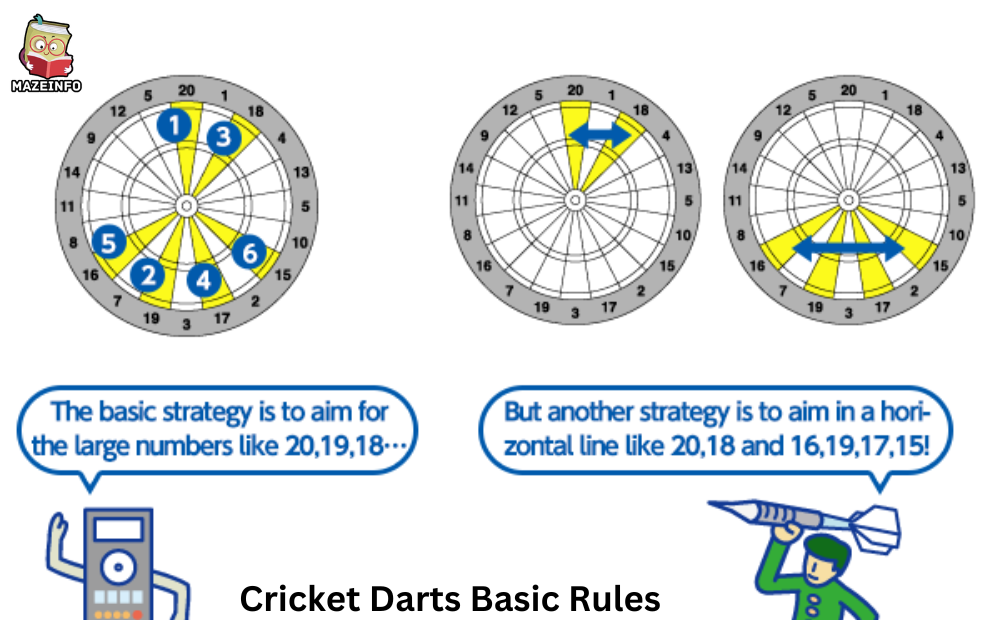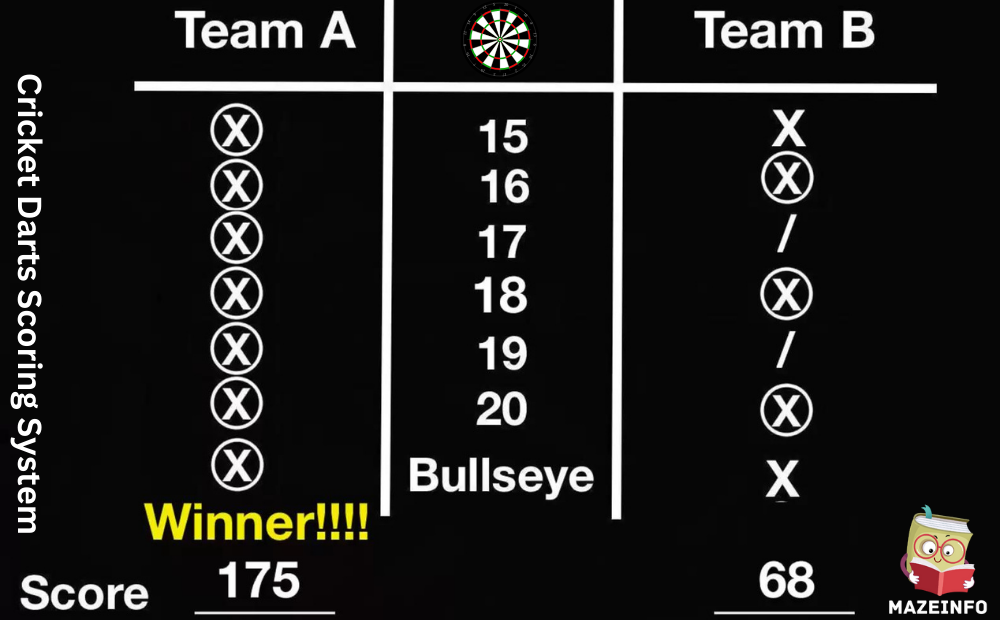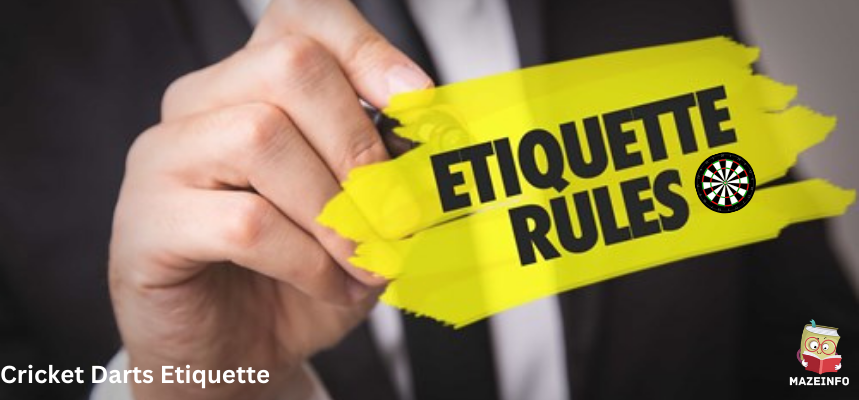Cricket darts, a captivating fusion of traditional darts and the strategic elements of cricket, offers a thrilling and dynamic gaming experience. This popular variation of the classic dart game requires players to not only showcase their precision in hitting specific targets on the dartboard but also to strategically outmaneuver their opponents by claiming and defending designated areas on the board. How to play cricket darts.
This question serves as the gateway to unlocking the intricacies of this engaging game. In the following guide, we will delve into the rules, techniques, and strategies that define cricket darts, equipping both beginners and seasoned players alike with the knowledge needed to step up to the oche and aim for victory. So, grab your darts, hone your aim, and let’s explore the exciting world of cricket darts together.
Setup and Equipment
Cricket darts is a popular dart game that can be played by two or more players. Here’s how to set up and the equipment you’ll need:
Equipment
Dartboard: A standard dartboard is used, typically made of sisal fibers or a similar material. The board is divided into numbered sections and features a bullseye at the center.
Darts: Each player will need their own set of three darts. Dart games come in various weights and styles, so players can choose what suits them best. It’s important that the darts are in good condition, with sharp tips and straight flights.
Scoring Device: You can use a traditional chalkboard or a digital scoring device to keep track of scores. Some electronic dartboards come with built-in scoring capabilities.
Setup
Mounting the Dartboard: Hang the dartboard securely on a wall or a dartboard stand, making sure it’s at the regulation height of 5 feet 8 inches (173 cm) from the floor to the center of the bullseye.
Throwing Distance: The throwing distance, also known as the “oche” or “throwing line,” should be marked on the floor. For most players, this is 7 feet 9.25 inches (237 cm) from the face of the digital dart board to the front of the oche.
Player Order: Decide on the order in which players will take their turns. This can be determined by a simple coin toss or by any agreed-upon method.
Gameplay
Scoring: The objective of cricket viper darts is to “close out” certain numbers on the dartboard while also accumulating points. The numbers 15 through 20 and the bullseye are typically used.
Closing Numbers: To close out a number, a player must score three of that number. For example, to close out the number 20, a player must hit the 20 section of the electronic dart board with three darts. Once a player closes out a number, they can begin scoring points on that number.
Scoring Points: After closing out a number, players can score points by hitting that number or the bullseye. Each hit on a closed number or the bullseye earns points equal to the numerical value of the section hit. For instance, hitting the 20 section earns 20 points.
Winning the Game: The game typically ends when all players have closed out and scored on each of the designated numbers. The player with the highest score at the end of the game wins.
Strategy: Players can employ various strategies, such as focusing on closing out numbers quickly or strategically targeting their opponents’ numbers to prevent them from scoring.
Also Read More: Technology in Cricket : 100 Years of Evolution & What’s Next?
Basic Rules

Cricket darts is a popular darts game played by two or more players or teams. The objective of the game is to “close out” certain numbers on the dart scoreboard and score more points than your opponent(s). Here are the basic rules:
Equipment: Cricket darts is played with a standard dartboard and a set of three darts for dartboard per player.
Players: Cricket can be played by two or more players or teams. If playing with teams, each player on the team takes turns throwing their darts.
Objective: The objective of cricket darts is to score points by hitting certain numbers on the dartboard and then “closing” those numbers by hitting them a certain number of times.
Numbers: In dart game cricket, the numbers 15 through 20 and the bullseye are typically used. Each player or team aims to “close out” these numbers.
Scoring: Players score points by hitting any segment of the numbers 15-20 and the bullseye. The numbers are scored as follows:
Numbers 15-20: Each hit on one of these numbers scores the value of the number hit.
Bullseye: The bullseye in the center of the dart board is typically divided into two sections – the inner bullseye (worth 50 points) and the outer bullseye (worth 25 points).
Closing Numbers: To close a number, a player or team must hit it three times. Once a player or team closes a number, they “own” that number, and their opponent(s) can no longer score points on it. However, the owning player or team can continue to score points on that number.
Strategy: Players must balance scoring points with closing out numbers. It’s often strategic to focus on closing numbers that opponents have not yet closed, while also scoring points to maintain or gain a lead.
Ending the Game: The game typically ends when all players or teams have closed out all numbers (15-20 and the bullseye). The player or team with the highest score at the end of the game wins.
Optional Rules: There are variations of cricket dart board darts with additional rules, such as requiring players to hit doubles or triples to close numbers, or allowing players to “come from behind” by closing out numbers that have already been closed by their opponents.
Scoring System

Cricket darts is a popular best electronic dart board game played on a standard dartboard. In this game, players aim to “close out” specific numbers on the dartboard by hitting them a certain number of times, typically three. The numbers used in cricket are 15 through 20, plus the bullseye.
To begin, players take turns throwing three darts for electronic dartboard each, aiming to hit any of the designated numbers. When a player hits a number, they score points equal to the number on the board (e.g., hitting a triple 20 scores 60 points). Once a player has scored points on a number, they “own” that number, and their opponent cannot score on it until the owning player has closed it out by hitting it three times.
The bullseye is typically worth 50 points, with the outer bullseye (or “bull”) worth 25 points. To win, a player must score points on all numbers and the bullseye and have a higher total score than their opponent. Additionally, the player who closes out all the numbers and the bullseye first can prevent their opponent from adding any further points to their total. This strategic element adds depth and excitement to the game as players balance scoring points with closing out numbers to secure victory.
Gameplay Strategies
Cricket darts is a popular dart game rules that is played by two or more players or teams. The objective of the game is to “close out” certain numbers on the dartboard and score the most points. Here’s a detailed guide on gameplay strategies for cricket darts:
Understanding the Rules: Before delving into strategies, it’s crucial to have a clear understanding of the rules of cricket bar darts. The game typically involves players aiming to hit numbers 15 through 20, as well as the bullseye. The numbers must be closed out by hitting them three times each, while the bullseye needs to be hit twice (outer bull) or once (inner bull) to close it out.
Starting Strong: A good start can set the tone for the entire game. Aim to hit the numbers with your initial throws, particularly focusing on the high-value numbers (15-20) and the bullseye. This will put you in a strong position early on and apply pressure on your opponent.
Strategic Targeting: In the initial stages of the game, prioritize closing out the high-value numbers (15-20) over the bullseye. This is because these numbers contribute more points per hit, and once closed, they deny your opponent the opportunity to score on them.
Defensive Play: If your opponent is leading or has closed out numbers ahead of you, consider employing defensive strategies. Focus on hitting the numbers they haven’t closed out yet to prevent them from scoring points. Additionally, aim for their scoring numbers to reduce their lead.
Risk Management: Assess the risk versus reward with each throw. For instance, if you only need one more hit to close out a number, it might be worth taking a riskier shot to secure it. However, if you’re far behind in points, prioritize hitting safer targets to accumulate points steadily.
Bullseye Strategy: Once you’ve closed out the main numbers (15-20), shift your focus to the bullseye. Hitting the bullseye consistently can rack up points quickly, especially if your opponent hasn’t closed it out yet. However, be mindful of the risk involved, as missing the bullseye can result in zero points.
Scoring Efficiency: Aim for triple and double segments whenever possible to maximize your scoring potential. While hitting the single segment is necessary for closing out numbers, focusing on the higher-scoring segments can give you a significant advantage.
Pressure and Mind Games: Use psychological tactics to put pressure on your opponent. This can include maintaining a steady rhythm, celebrating successful throws, or showing confidence even when you’re behind. By creating a tense atmosphere, you may force your opponent into making mistakes.
Adaptability: Be prepared to adapt your strategy based on the current state of the game. If your opponent closes out numbers unexpectedly, adjust your focus accordingly. Flexibility is key to staying competitive throughout the game.
Practice and Patience: Like any skill-based game, improving at cricket dart board cupboard requires practice and patience. Experiment with different strategies, learn from your mistakes, and hone your dart-throwing skills over time.
Variations

Cricket darts is a popular dart game played by many enthusiasts worldwide. The standard version of cricket involves players aiming to hit specific numbers on the dartboard in order to “close” them, and then subsequently score points by hitting those same numbers again while preventing their opponent from doing so. However, there are several variations of cricket darts that add different twists and challenges to the game. Here are some variations you might enjoy:
Cut-Throat Cricket: In this variation, players not only try to close numbers but can also score points by hitting their opponents’ numbers. This adds an element of strategy as players must decide whether to focus on closing their own numbers or interfering with their opponents’ progress.
No Score Cricket: In this version, players aim to close numbers without scoring any points. Points are only earned by hitting the numbers after they are closed. This variation requires careful planning and precision to win.
Crick ’01: This variation combines elements of cricket with the ’01 games like 301 or 501. Players aim to close numbers as in regular cricket, but they must also reach a target score (e.g., 301 or 501) to win the game. Each player takes turns throwing three dartboard and darts and subtracts the total score from their current total until they reach zero.
Round the Clock Cricket: Players must hit each number on the dartboard in sequential order, starting from 1 and ending with the bullseye. Once a number is hit, it is considered closed, and players can start scoring points by hitting those numbers again. The player who closes all the numbers and scores the most points wins.
Wild Card Cricket: In this variation, players agree on a “wild card” number before the game starts. This number cannot be closed, but hitting it earns a predetermined amount of points. Players must strategize when to aim for the wild card number while also trying to close other numbers to score points.
Quick Cricket: This is a fast-paced version of cricket where players aim to close all numbers (usually 15 through 20 and the bullseye) as quickly as possible. Once a number is closed, players can start scoring points by hitting it again. The player who closes all the numbers and scores the most points first wins.
Etiquette

In the game of cricket darts, etiquette plays a crucial role in maintaining a respectful and enjoyable atmosphere for all players involved. Firstly, it is customary to wait until your turn to throw before retrieving your darts from the board, ensuring that you do not disrupt the flow of the game or distract other players.
Additionally, showing good sportsmanship by congratulating opponents on well-played shots and maintaining a positive attitude, regardless of the outcome, fosters a friendly environment. It’s also important to refrain from excessive celebration or gloating, as this can be seen as disrespectful to fellow competitors. Furthermore, adhering to the darts rules and regulations of the game demonstrates integrity and fairness, enhancing the overall experience for everyone participating. By observing these etiquettes, players can contribute to a harmonious and enjoyable cricket darts set match for all involved.
Conclusion
To play cricket darts, each player takes turns throwing three darts per round, aiming to hit numbers on the dartboard ranging from 15 to 20, as well as the bullseye. The objective is to “close out” each number by hitting it three times, which means landing three darts in that particular section of the dart backboard. Once a player closes a number, they “own” it, and subsequent hits on that number score points.
The bullseye typically serves as a wildcard, offering either a set number of points or the ability to close out any number the player chooses. The game continues until all numbers are closed, and the player with the highest dart scorer at the end wins. In conclusion, cricket darts is a strategic and engaging game that requires precision, consistency, and the ability to adapt to changing circumstances on the dartboard. It’s a test of both skill and mental agility, making it a favorite among darts enthusiasts worldwide.
Frequently Asked Questions (FAQ)
Q: What equipment do I need to play cricket darts?
Ans: You’ll need a dartboard, a set of darts, and a suitable throwing area with proper distance markings.
Q: How many players can participate in cricket darts?
Ans: Cricket darts can be played with two or more players, though it’s commonly played one-on-one or in teams of two.
Q: How do you score points in cricket darts?
Ans: Points are scored by hitting specific numbers on the dartboard (15 through 20, plus the bullseye). Each hit on a number opens it for scoring, and subsequent hits on that number increase the score. Hits on numbers not yet opened do not count.
Q: What is the objective of cricket darts?
Ans: The objective is to score points by hitting and closing numbers while preventing your opponents from doing the same. The player or team to close all numbers and have the highest score wins.
Q: Can you explain the concept of “closing” numbers in cricket darts?
Ans: “Closing” a number means hitting it three times. Once a player or team has closed a number, they “own” it, and their opponents can no longer score points on that number.



